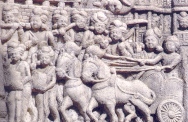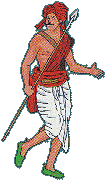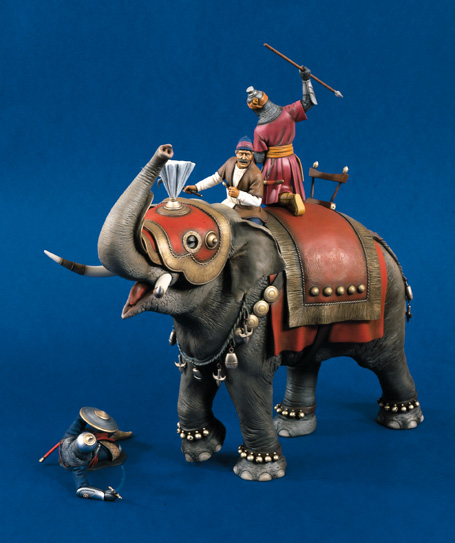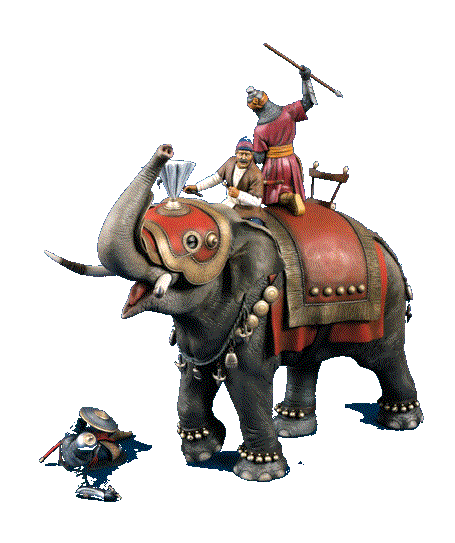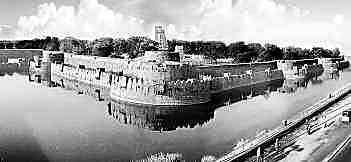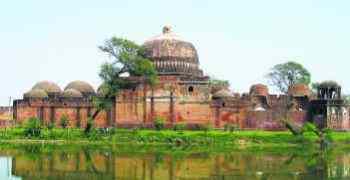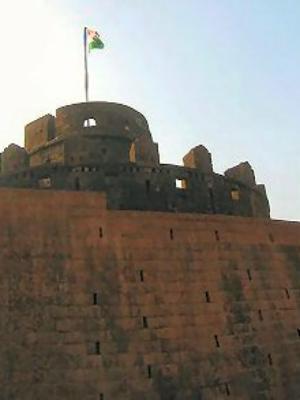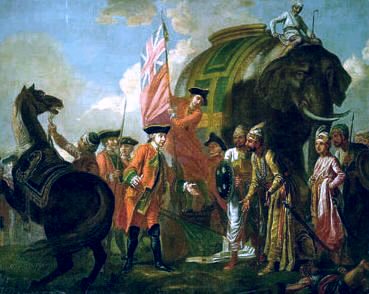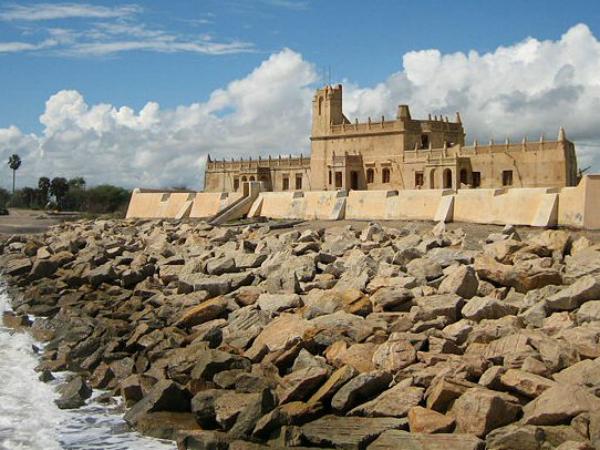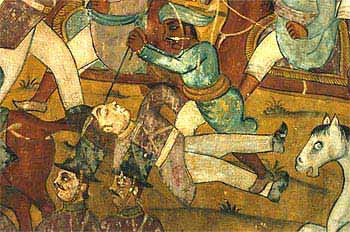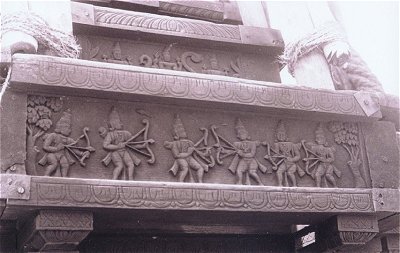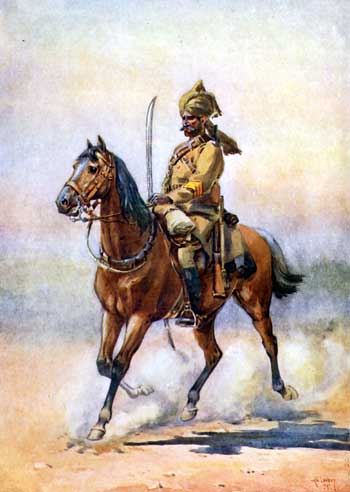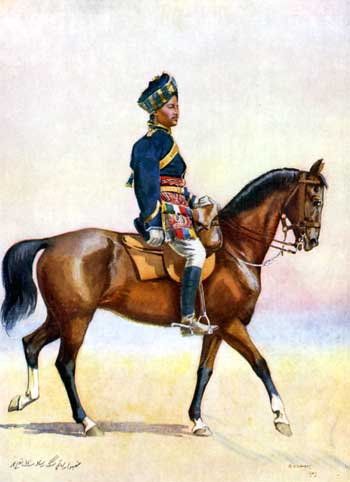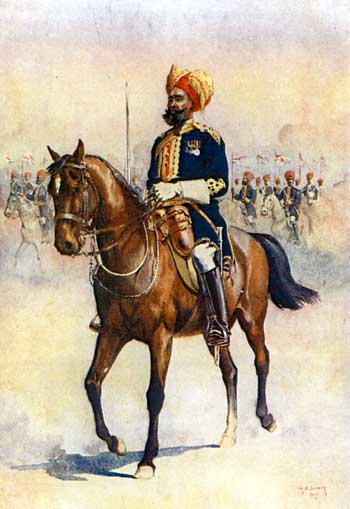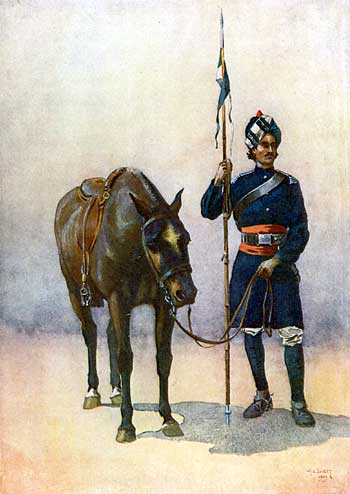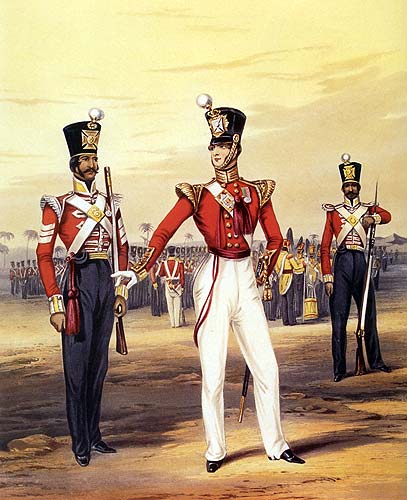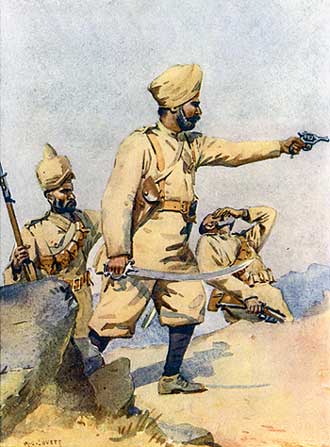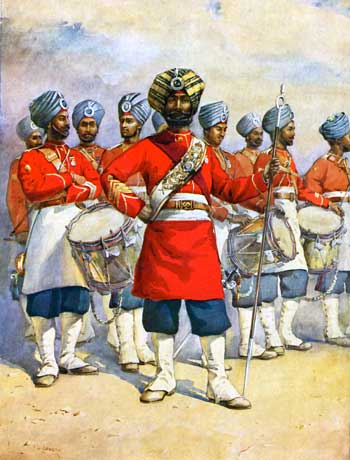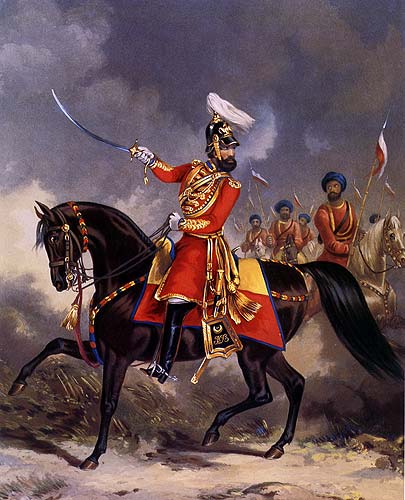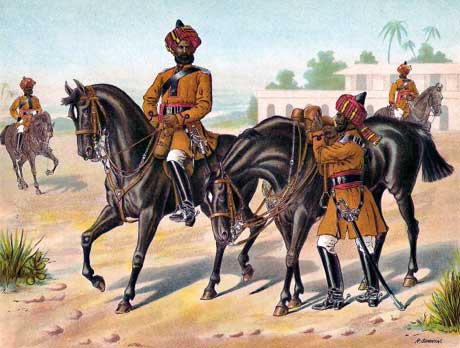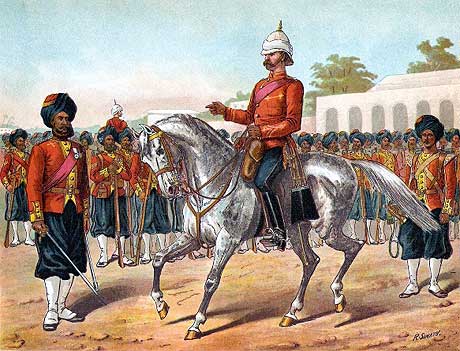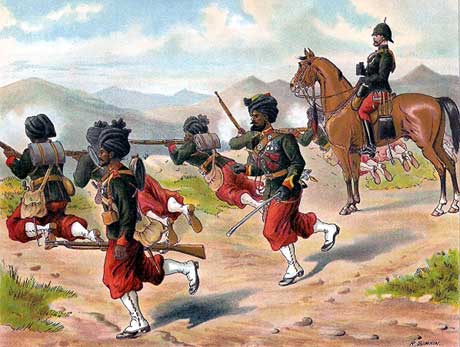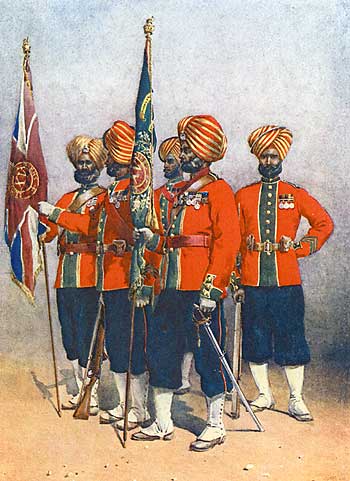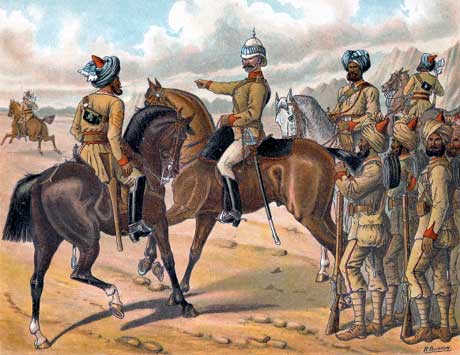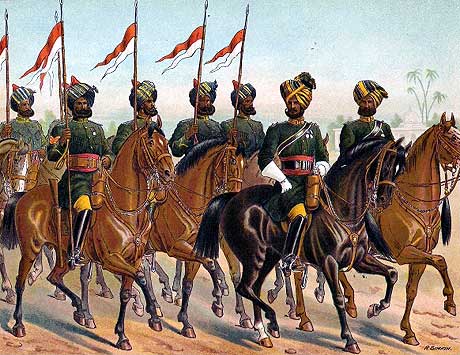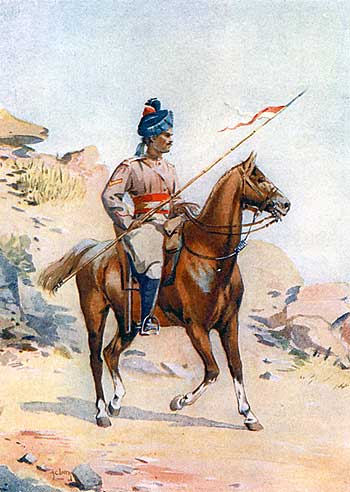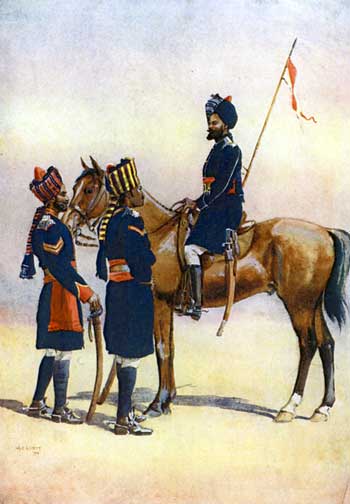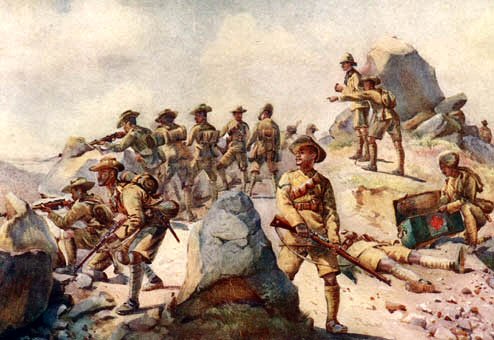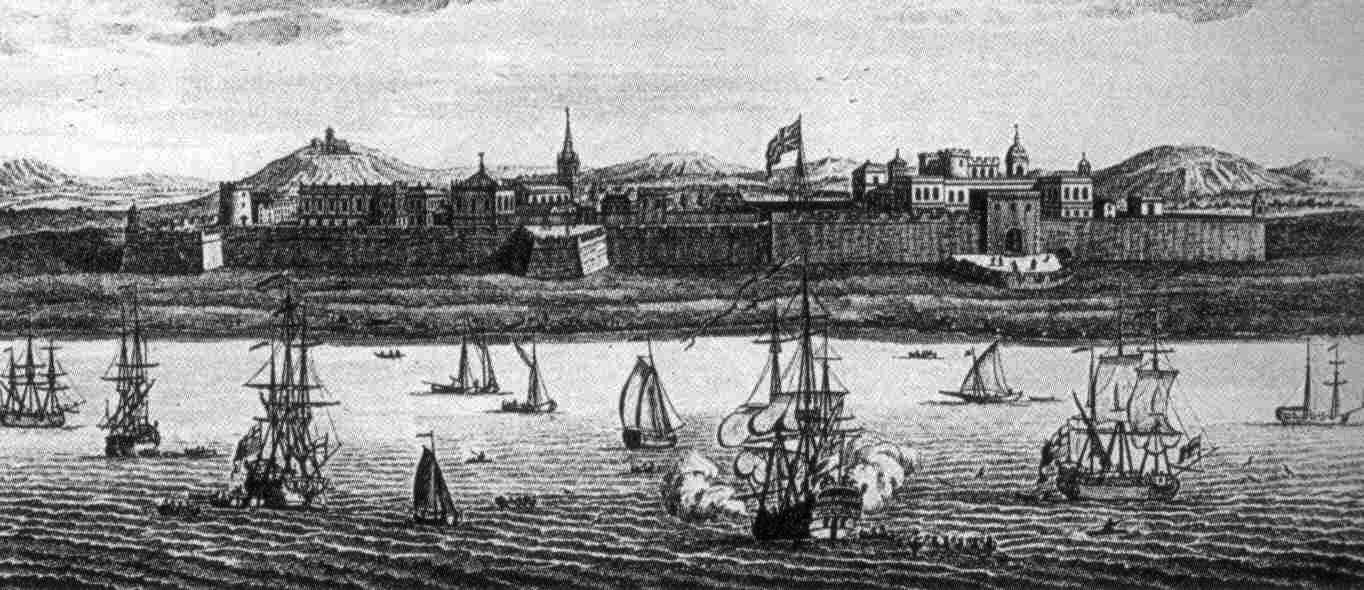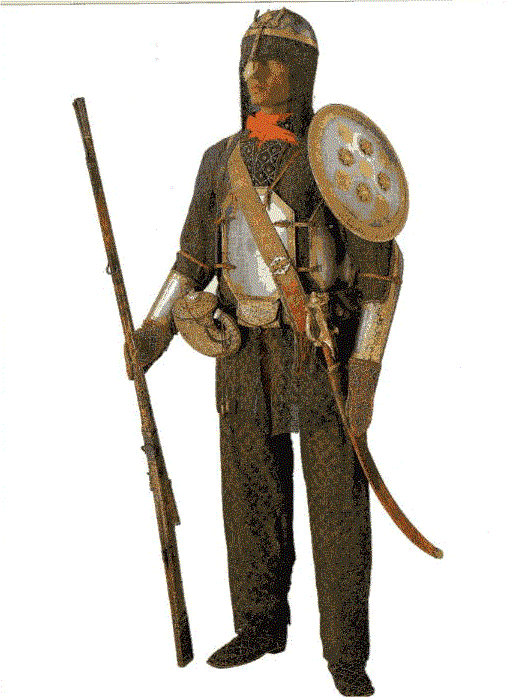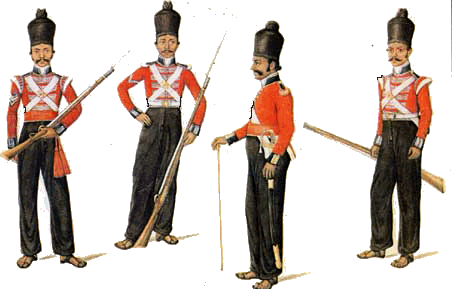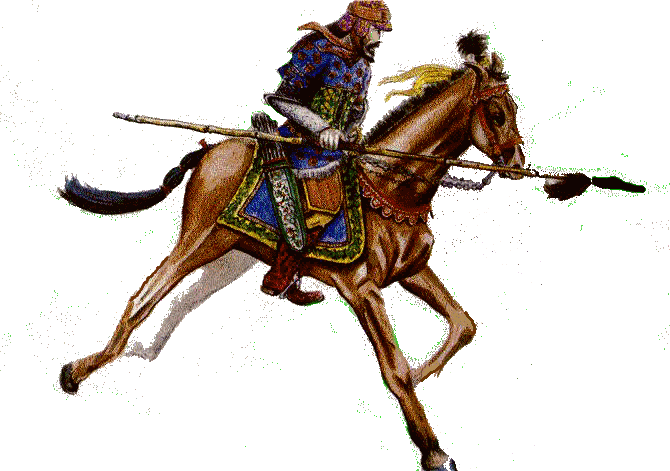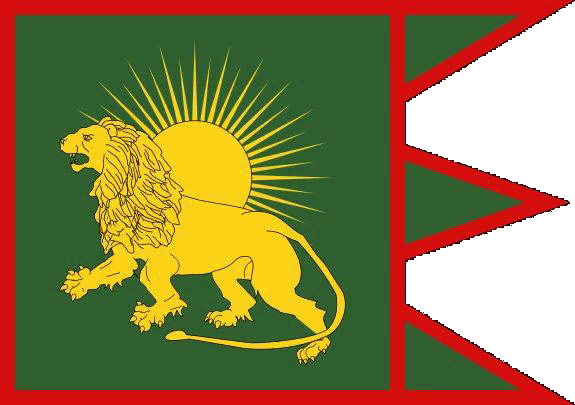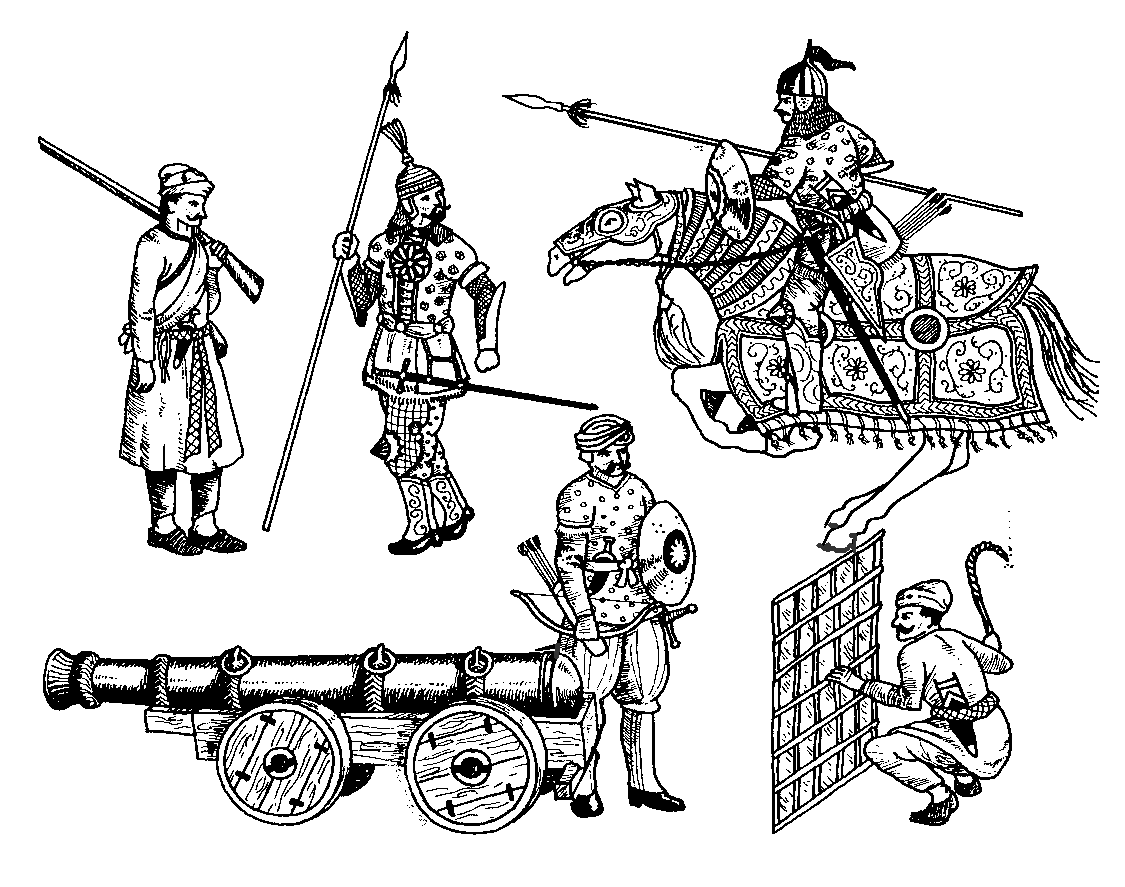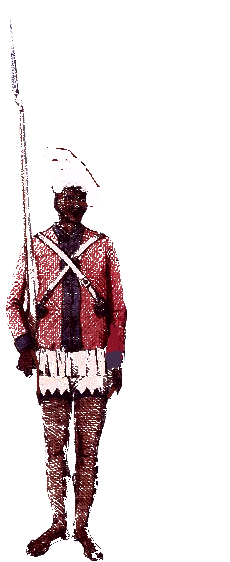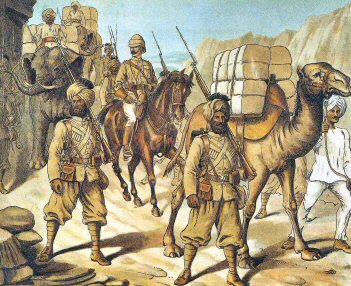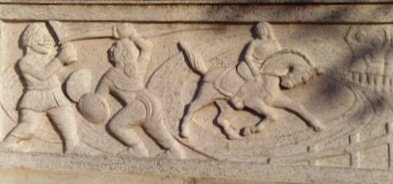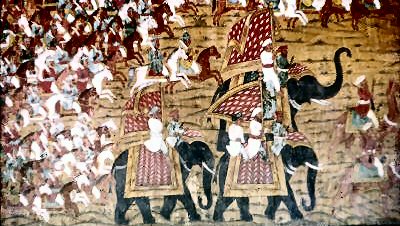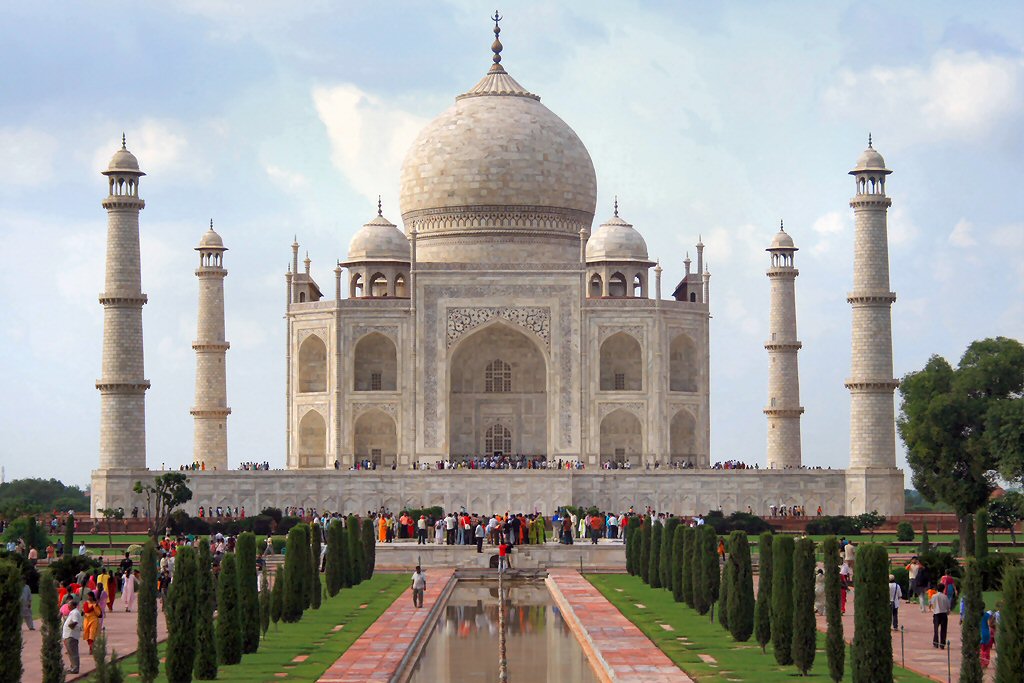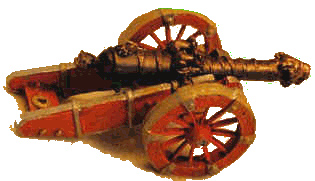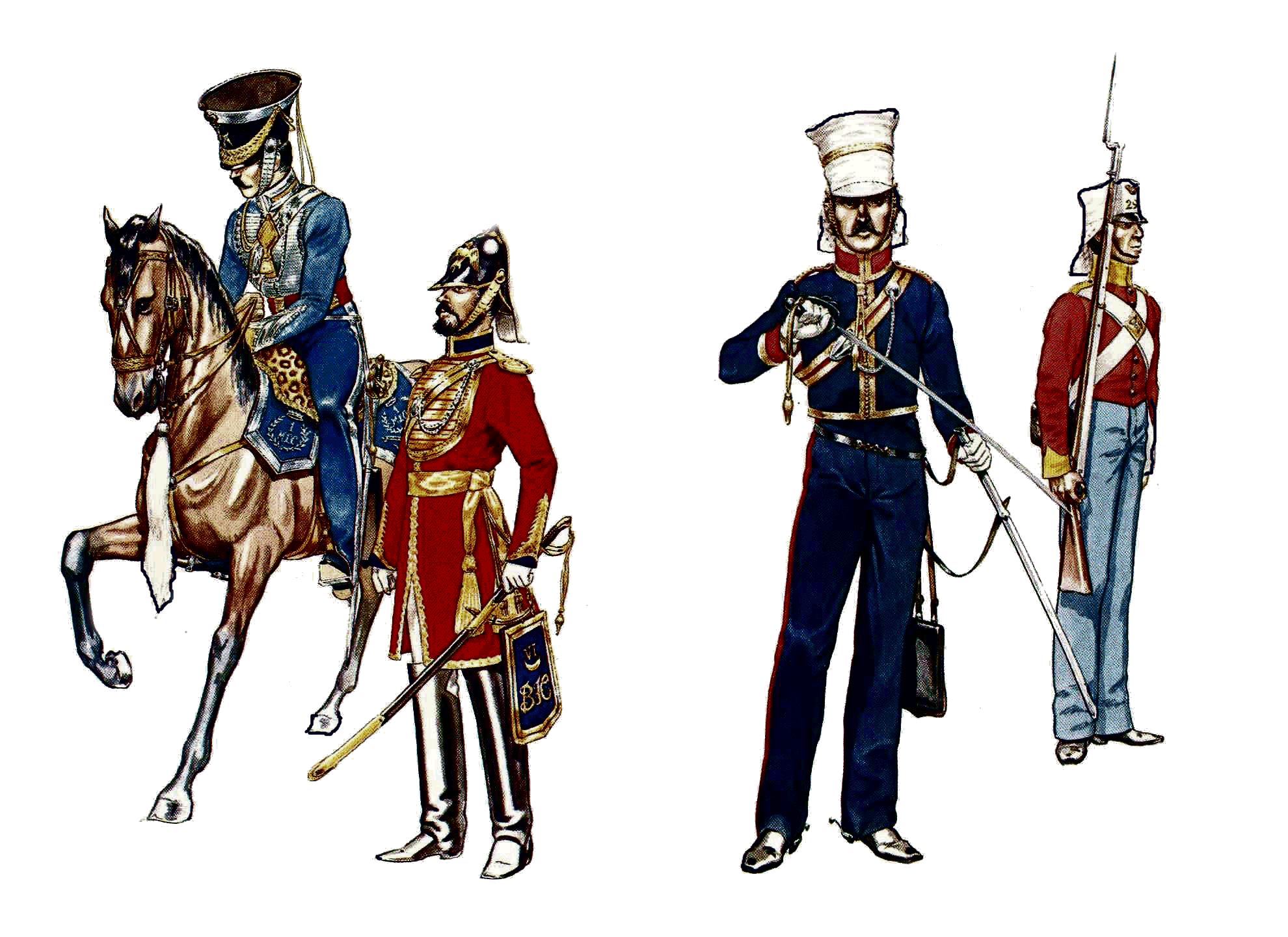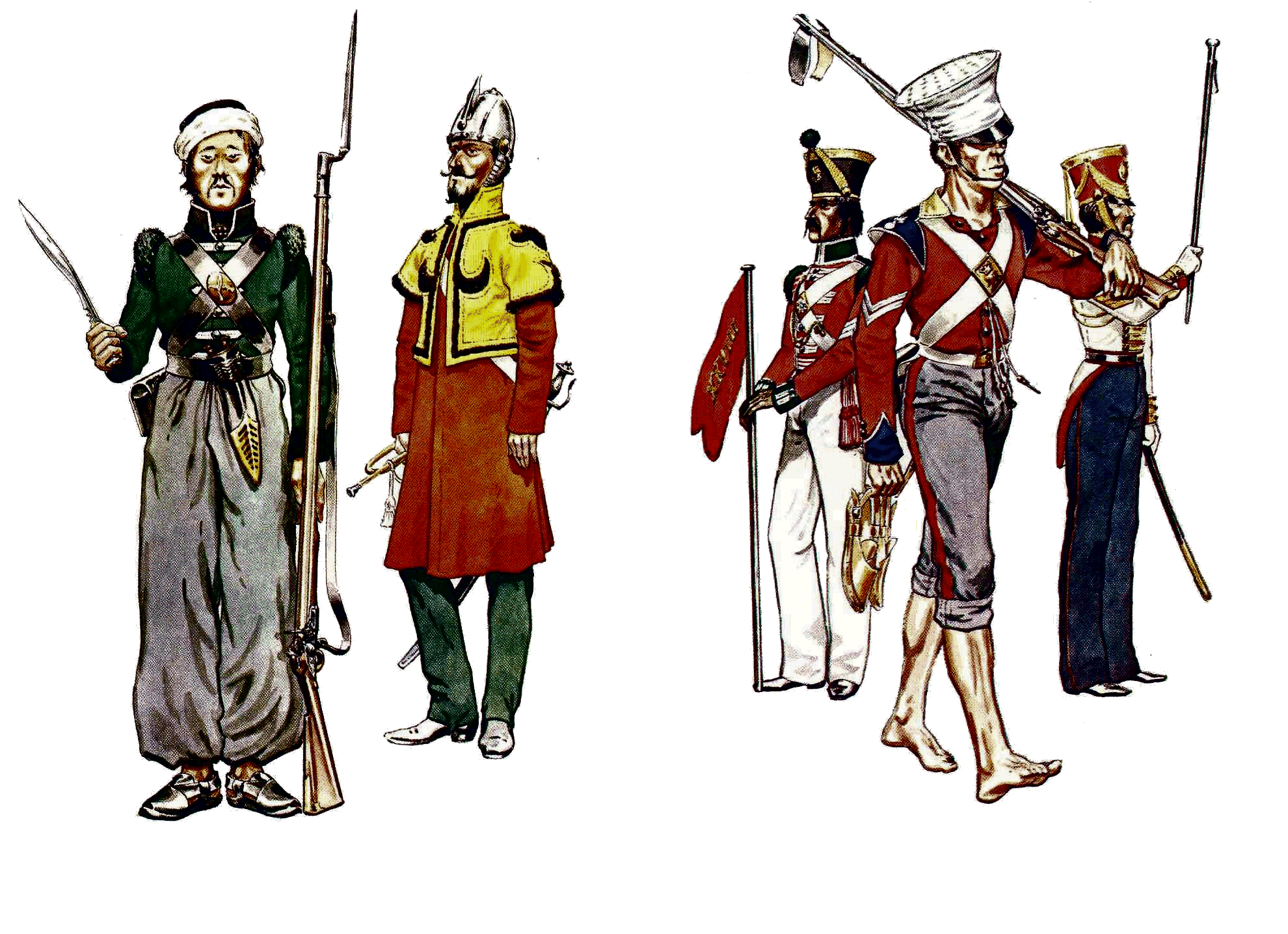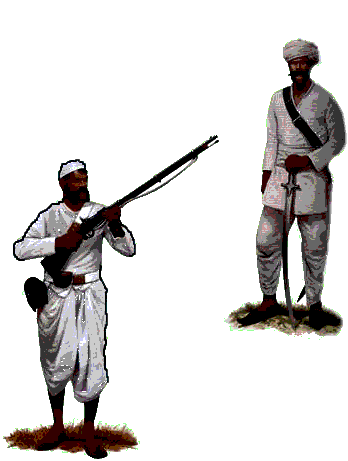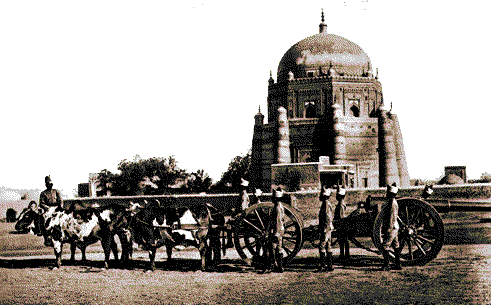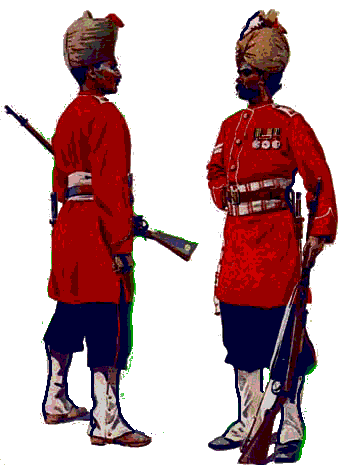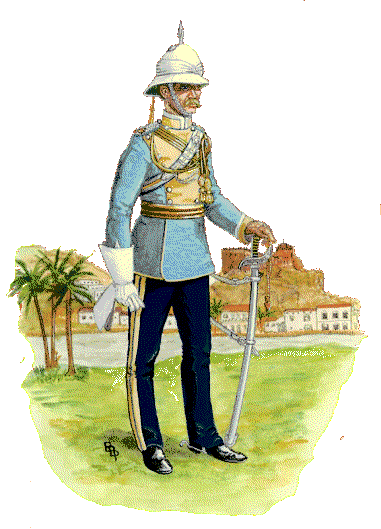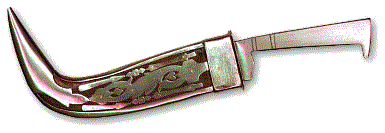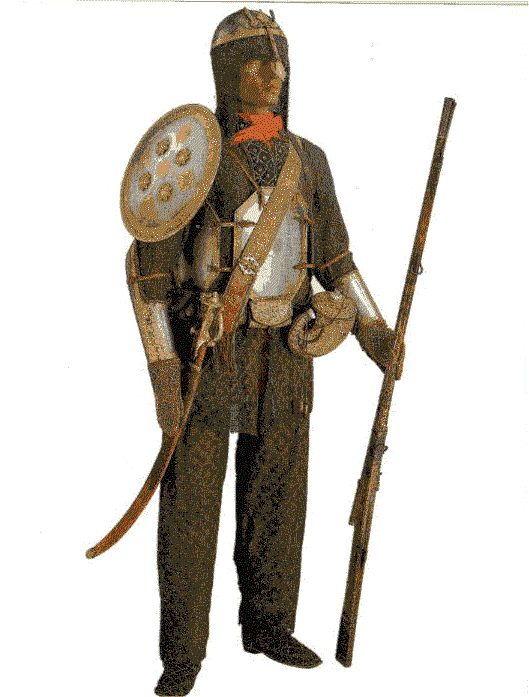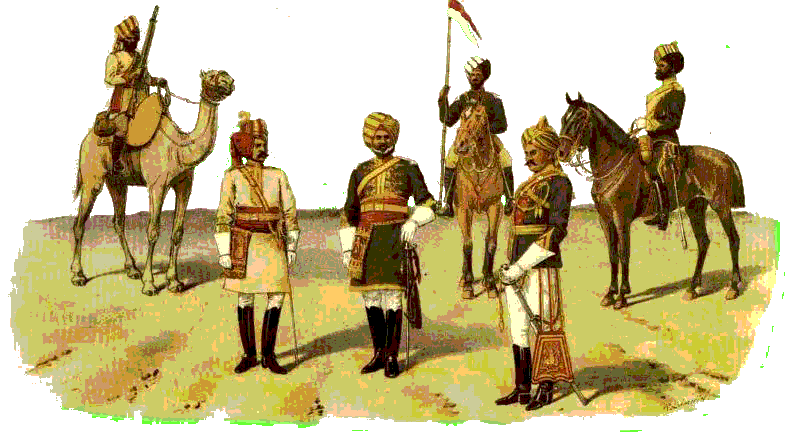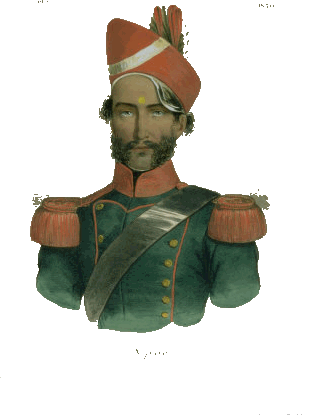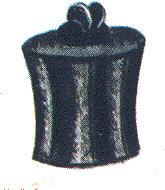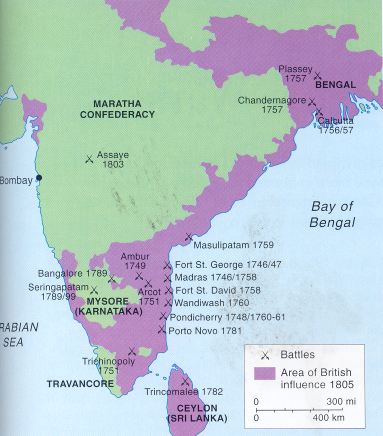Battle of Mavil Aru
Sparked when the Tamil Tigers or LTTE blocked a sluice gate supplying water to some 30,000 acres of paddy field in government-held areas in the country's east. An 18-day operation by 2,000 troops to recapture this area ended only on 15 August with government forces in control of the main sluice gates at Mavil Aru, although sporadic mortar and artillery fire was continuing. At the turn of 2007, government forces pushed north from Trincomalee to occupy long stretches of the coastline, while at the same time pushing south from Jaffna through successive LTTE defence lines.
From: Eastern province of Ceylon
battle/siege of Massaga C4BC Tuesday, 11/28/06, 7:27 AM
Arrian attests that besides 20000 cavalry and 30000 infantry, the Assakenians had employed 30 war elephants against Alexander in the battle/siege of Massaga in Pakistan, which preceded the Hydaspes battle.
From: Pakistan
battle of Kurukshetra Tuesday, 11/28/06, 7:11 AM
"Kurukshetra" is in fact the name of a mythological battlefield, where the Mahabharata war was waged, the actual location of which is impossible to confirm. Local hearsay identifies the legendary "Kurukshetra" with a nearby obscure hamlet, and with the active abetment of the state government, it is presently experiencing a tourist boom. In some ancient Hindu texts, the boundaries of Kurukshetra correspond roughly to the state of Haryana. Thus according to the Taittiriya Aranyaka 5.1.1., the Kurukshetra region is south of Turghna (Srughna/Sugh in Sirhind, Punjab), north of Khandava (Delhi and Mewat region), east of Maru (=desert) and west of Parin.[1]
From: Haryana state
Web Site: Wikipedia
Seven mediaeval battles on the subcontinent: Tuesday, 11/21/06, 9:01 AM
Three battles of Panipat in 1399, 1526 and 1556. Talikot 1565, 80 miles north of Vijayanagar, in central India. Moghuls fought Rajputs indecisively at Haldighati 1576, 30 miles north of Udaipur in Rajastan. Two battles of Tarain 1191 and 1192: Afghans lost to Rajputs first time, but were victorious the following year.
History of Sri Lanka Friday, 9/1/06, 6:54 AM
From: Sri Lanka
Web Site: Wiki
military history of Sri Lanka Monday, 6/19/06, 8:21 AM
An excellent source: Anton Muttukumaru ¿The military history of Sri Lanka ¿ an outline¿ New Delhi, Navrang, 1987
From: Sri Lanka
The Ancient Greeks in India Tuesday, 4/18/06, 11:13 AM
Alexander left behind Greek forces which established themselves in the city of Taxila, now in Pakistan. Several generals governed the newly established province. One of them, Sophytes (305-294 BCE), was an independent Greek prince in the Punjab. Within a few years local India monarchs recaptured the region from the Greeks. Chandragupta Maurya, who had met Alexander in Taxila, founded the Mauryan empire. Seleucus I Nicator was founder of the Seleucid dynasty and one of Alexander's former generals. He invaded India (modern Punjab in northern India and Pakistan) in 304 BCE. It is said that Chandragupta Marya put an army of 100,000 men and 9,000 war elephants and forced Seleucus to conclude an alliance. Seleucus gave him his daughter in marriage, ceded the territories of Arachosia, and received from Chandraguta 500 war elephant which he used decisively at the Battle of Ipsus. Seleucus also sent an ambassador named Megasthenes to Chandragupta's court, who repeatedly visited Pataliputra (modern Patna in Bihar state), capital of Chandragupta. Megasthenes has written detailed descriptions of India and Chandragupta's reign. Continued diplomatic exchanges and good relations are between the Seleucids and the Mauryan empirors are then documented throughout the duration of the Mauryan empire. The founder of the Indo-Greek Kingdom was Demetrius I (205-171 BCE), shown on a coin wearing the scalp of an elephant, symbol of his conquest of India. In 180 BCE, the Indo-Greeks, invaded parts of northwest and northern India. They are an extension of the Greco-Bactrian dynasty of Greek kings (the Euthydemids) located in neighbouring Bactria. The invasion of northern India followed the destruction of the Mauryan dynasty by the general Pusyamitra Sunga, who then founded the new Indian Sunga dynasty (185 BCE-78 BCE). The Indo-Greek king Demetrius I of Bactria went as far as the capital Pataliputra in eastern India (today Patna): "Those who came after Alexander went to the Ganges and Pataliputra" (Strabo, XV.698). The Indian records also describes Greek attacks on Saketa, Panchala, Mathura and Pataliputra (Gargi-Samhita, Yuga Purana chapter). The Indo-Greeks ruled various part of northern and northwestern India until the end of the 1st century BC, while the Sungas remained in the east. Buddhism flourished under the Indo-Greeks, leading to the Greco-Buddhist cultural syncretism. The arts of the Indian sub-continent were also quite affected by Hellenistic art during and after these interactions. The Hunza tribe in the Pakistani part of Kashmir is said to have descended from Greek generals based there.
From: northern India
Web Site: Wiki
First Anglo Sikh War 1845-46 Wednesday, 4/5/06, 5:24 AM
From: Punjab
Web Site: Punjabilok
The Mauryan Empire. Wednesday, 4/5/06, 5:20 AM
In the last weeks of 327 BC, Alexander the Great invaded the valley of the river Kabul, and in the next months, he conquered Taxila, defeated the Indian king Porus at the river Hydaspes, and reached the eastern border of the Punjab. He wanted to continue to the kingdom of Magadha in the Lower Ganges valley, but his soldiers refused to go any further. However, his invasion changed the course of Indian history. In Taxila, a young man of the warrior caste, named Chandragupta Maurya, had seen the Macedonian army, and -believing that anything a European could do an Indian could do better- decided to train an army on a similar footing. In 321, he seized the throne of Magadha and thereafter conquered Taxila himself. The Seleucid Greeks, involved in infighting with other successors to Alexander, ceded him what is now Afghanistan. The Mauryan empire was born.
From: North India
Web Site: Livius
The Military history of Sri 777AD ¿ 1216AD Wednesday, 1/18/06, 11:25 AM
The fascinating history behind such famous tourist sites as the Fortress of Sigiriya.
From: Lanka
Web Site: War Tourist
History of the House of Mewar Monday, 1/16/06, 11:36 AM
The Maharanas of Udaipur claim to descend from the Sun God himself. Their history is here recounted in great detail up to modern times, and nicely illustrated too.
From: Udaipur, Rajasthan
Web Site: House of Mewar
Eight battles in Bangladesh Monday, 1/16/06, 11:29 AM
Battle of Chausa (1539) Sher Shah established the supremacy of the Sur Afghans http://banglapedia.search.com.bd/HT/H_0188.htm Battle of Kanauj 1540 at http://www.banglapedia.net/HT/T_0075.HTM Battle of Tukaroi (1575) http://www.banglapedia.net/HT/R_0073.HTM Battle of Rajmahal 12 July 1576. The reinforced Mughals beat the Afghans, inaugurating Mughal rule in Bengal. http://www.banglapedia.net/HT/R_0073.HTM battle of Palashi (Plassey) 23 June 1757. Robert Clive¿s famous victory over Nawab Sirajuddaula. http://www.banglapedia.net/HT/P_0044.HTM Battle of Buxar (1764) marked the final ascendancy ofthe English East India Company. http://www.banglapedia.net/HT/B_0668.HTM Battle at Pukhuria 1782 at http://www.banglapedia.net/HT/F_0009.HTM The War Of Independence Against Pakistan 1971
From: Bangladesh
Web Site: Banglapedia
Two battles of Tarain (Panipat) 1191 and 1192 Monday, 1/16/06, 11:22 AM
¿Muhammad of Gaur's invasion of India followed that of Muhammad of Ghazni, another Central Asian king who invaded India first in 1000 AD. The Gaurs, having overthrown the Ghaznavids, established their own kingdom in Central Asia and Muhammad of Gaur was determined to extend his rule over India. Muhammad of Gaur began his Indian campaigns. He captured the strong fortress of Uch. However his invasion of Gujarat proved to be a failure. During his conquest of India, Muhammad of Gaur had conflicts with the Rajputs, especially with Prithviraj Chauhan, king of Ajmer and Delhi. In 1190- 91, Muhammad of Gaur marched beyond Punjab but Prithviraj and his troops harassed the Muslim troops, and soon defeated them. Muhammad was severally wounded and so went back to Ghazni. Muhammad did not become disheartened. He soon raised a very strong army to avenge his defeat. He invaded India in 1192 with adequate preparations. The battle was on the same field (Tarain near Thanesar) where he had his previous defeat. Muhammad of Gaur has now comprehensively routed th Rajputs in the Second Battle of Tarain. Prithviraj Chauhan was captured and put to death¿
From: Near Thanesar
Web Site: Mewar India
The Fakir-Sannyasi Revolt 1760s ¿ 1790s Monday, 1/16/06, 11:08 AM
The East India Company issued decrees banning collection of alms by the Fakirs and Hindu Sannyasis. The resisting fakirs belonged to the Madaria tarika, a Sufi sect which flourished in Bengal. The Sannyasis were Vedantic Hindu yogis. Both the fakirs and sannyasis formed armed bands. In rituals and practices there was good deal of affinity between the Sufi Fakirs and Yogi Sannyasis that contributed to their common alliance against the British. The Fakir-Sannyasi movement was led by MAJNU SHAH, a Sufi saint. Bhabani Pathak, a Bhojpuri Brahmin led the Sannyasi rebels. Lieutenant Brenan was deputed to contain the resistance movement. The rebels used swords, spears and lances, guns, fire throwing devices, hawai and even revolving cannons. some Fakirs were horsed. Camels were used for carrying provisions and ammunitions. Sometimes there was assemblage of five to six thousand rebels, and rebel numbers rose to fifty thousand or more in the 1770s. The rebels had intelligence agents in the villages. To check the activities of the rebels in North Bengal an English army was sent to Rangpur in 1767 under Captain Mackenzie. Meanwhile the rebels defeated an English contingent sent by Barwell, the Resident of Maldah, under the command of Myrtle who was killed by the rebels. At the approach of Mackenzie with his army the rebels retracted towards Nepal. During 1768-70 fakir-sannyasi raids mainly continued in Saran (Bihar), Benares, Purnia, Rangpur, Dinajpur, Rajshahi, Comilla and Chittagong districts. An army under Feltham suddenly attacked the rebels in 1771 on the road to Ghoraghat and Govindganj in Rangpur where they sustained a defeat and were dispersed. In 1772 Majnu Shah raided the establishments of the company in the Rangpur, Rajshahi and Bogra districts. The rebels conducted extensive raids in Purnia, Burdwan, Kumarkhali, Jessore, Mymensingh, Sylhet, Dhaka, Midnapore, Birbhum, Rangpur, Dinajpur, Bogra, Jalpaiguri in 1773. Fakir-Sannyasi raids intensified in 1776 in the districts of Bogra, Rajshahi, Dinajpur and Chittagong. During the period between 1777 and 1781 the raids continued in Bogra, Rajshahi, Rangpur, Chittagong, Sylhet and Mymensingh areas. In 1782, after a severe battle at Pukhuria, Majnu Shah receded into the Madhupur jungle with his followers. In 1785 he proceeded towards Mahasthangarh and was defeated in a battle. In the following year Majnu Shah planned simultaneous attack in eastern Bengal under himself and in North Bengal area under his lieutenant Musa Shah. In a battle against a company army under Lieutenant Brenan in the Kaleswar area (8 December 1786) Majnu Shah lost a large number of his followers. It appears that he himself was wounded in the battle at Kaleswar and died sometime in late 1787 or early 1788 AD. After the death of Majnu Shah his able lieutenants like Musa Shah, Cherag Ali Shah, Paragal Shah, Sobhan Shah, Madar Baksh, Jari Shah, Karim Shah, Kripanath, Rowshan Shah, Anup Narayan and Sri Nibash continued the revolt until 1812. However in the late 1790s, the rebels fell out and most parts of Bengal came under firm British control.
From: Bengal
Web Site: Banglapedia
First and Second Battles of Pollilur 1780 and 1781 Monday, 1/16/06, 10:36 AM
The site is little-known (and often confused with nearby Pullalur). The battle field is marked only by two small obelisks - which commemorate two British officers, Capt. James Hislop and Colonel George Brown, who died there in 1781. This was the site of the Mysorean Tipu Sultan's great victory, on 20th September 1780, over a British contingent, commanded by Colonel William Baillie. Colonel Baillie is commemorated at Seringapatam, where he died, a prisoner of Tipu. After the humiliating defeat at Pollilur, the British retaliated and defeated Haidar at Porto Novo on 1st July 1781. The contest , in which 80-100,00 of Haidar's troops faced little more than 7,800 British, was as unevenly matched as the Battle of Pollilur had been. After next surrendering Tirupasur, Haidar decided to offer battle to Sir Eyre Coote on the same auspicious field as that of the Mysorean victory over Colonel Baillie the previous year. Again, Haidar's forces vastly outnumbered the British, but they, often on the brink of disaster, managed to gain a close victory. For this, Sir Eyre Coote acknowledged in particular the steady and gallant conduct of his Indian troops. The campaign concluded with the famous action at Seringapatam.
From: 10 miles North West of Conjeeveram (modern Kanchipuram) and 56 miles from St Thomas's Mount, Madras.
Web Site: National Galleries of Scotland
The several battles at Panipat Monday, 7/19/04, 9:07 AM
At least three battles were fought on the broad flood plain at Panipat, including two separate battles by the early Mogul Emperors. The battle fought here on January 14, 1761 was one of the bloodiest bloodiest battles ever recorded. It is estimated over 100,000 people were killed in just twelve hours.
From: 80 miles north of Delhi, Haryana State, India
History of Bangladesh Monday, 7/19/04, 9:00 AM
...sadly out of action at the time of my first visit.
From: Bangladesh
Web Site: Natl Encyclopedia of Bangladesh
History of Pakistan Monday, 7/19/04, 8:57 AM
From: Pakistan
Web Site: Story of Pakistan
Indian history Monday, 7/19/04, 8:55 AM
From: India!
Web Site: Web India
Two battles of Humayun Monday, 7/19/04, 8:53 AM
In the mid-sixteenth century, the Mogul Emperor Humayun fought two battles against Sher Shah, the ¿Afghan¿ ruler of Bengal and Bihar. The first battle, at Chausa, was fought across a tributary of the Ganges, on the south bank of the great river. Sher¿s camp faced east towards his base at Gaur. Humayun¿s faced west towards his capital Agra and contained many ladies of his Harem. His brother Kamran, who should have joined him with 10,000 Kabul horse, instead stood off in the hope of becoming Emperor should Humayun be defeated. The tributary river flowed between steep banks in between the camps, making an attack either way very difficult. After two months of stalemate, a truce was agreed, whereby Sher Shah would march his troops off unmolested towards the east, bypassing the Mogul camp. He constructed a bridge across the tributary and commenced to march his troops away. At a set time, however, these troops turned back towards the Mogul camp, and were joined by fresh troops pouring over the new bridge. Humayun, who may have been in one of his regular opium trances, was surprised and lost almost his entire force. He only escaped himself by floating across the Ganges on an inflated leather bag, in the company of a water carrier (who was later ennobled). His infant daughter Aqiqa vanished together with many other royal ladies of the Harem. Having assembled another army, which included 5000 matchlock men, 60 heavy guns, and hundreds of smaller ones, Humayun marched out and again confronted Sher Shah, who had an army only half the size. The armies met at Kanauj on opposite sides of the Ganges itself. This made a battle impossible and so Sher offered to withdraw some miles so that Humayun could cross the river and give battle. Humayun crossed onto low lying ground on the north bank, and Sher waited until the going was made difficult there for guns, etc. by a heavy rainstorm. He then sent cavalry around the flanks and attacked the Mogul army and camp followers while their mobility was limited and their retreat blocked by the Ganges. The Mogul army was destroyed utterly, and again Humayun was lucky to escape the field, crossing the Ganges this time on an elephant. The Moguls were forced right back to their base in the Kingdom of Kabul, and replaced temporarily in Hindustan by the alternative ¿Afghan¿ regime of Sher Shah. The Moguls were only able to return to Hindustan eventually because of the chronic disunity of their Afghan rivals. A notable feature of these early Mogul battles was that the artillery would be bound together by the wheels with tough leather thongs, to prevent horsemen galloping between them, after the Ottoman fashion. Matchlock men would be stationed in between the guns too.
From: the early Mogul Empire
Battle of Sadras 1782 Friday, 2/6/04, 8:36 AM
17 February 1782, during the American Independence War, the French Admiral Suffren (12 ships) onfronted Admiral Edward Hughes' British squadron (9 ships) off Madras (on the Coromandel Coast of India) in the 'Battle of Sadras'. [Sadras is a small town south of Madras, the major British-held port. Some refer to this battle as that of 'Madras'.] Though neither side lost a ship, the mutually inflicted damage to their squadrons caused both naval commanders not to continue the engagment the following day. Hughes headed for Trincomlee (northeast coast of Ceylon) for repairs. Suffren went to Pondicherry (immediately south of Sadras), which had been recently retaken from the British by Hyder Ali. Suffren quickly made repairs, and in March continued on his mission to deliver French troops south of Porto Novo, a small town south of the British-held port of Cuddalore. The French captured Cuddalore on 4 April
From: Coromandel Coast
Colonial Ceylon Thursday, 1/22/04, 11:32 AM
goes into a goodly amount of detail about the Portuguese period and possibly more.
From: UK via New Zealand
Web Site: Stephen Thomas
some battles of the Indian peninsula Friday, 11/7/03, 7:20 AM
Peshawar, 1001 Somnath, 1024 Tataori, 1192 Indus 1221 Delhi I, 1398 Meerut, 1399 Diu, 1509 Goa, 1510 Panipat I, 1526 Panipat II, 1556 Talikota, 1565 Wandewash 17xx Plessey 1757 Madras I, 1746 Arcot, 1751 Panipat III, 1761 Buxar, 1764 Miani, 1843 Hyderabad, 1843
Armies of the Kushan Empire Tuesday, 8/12/03, 12:18 PM
From: Northern India and Bactria
Web Site: Armies of the Kushan Empire
Sources for Ceylonese military history: Tuesday, 8/12/03, 11:15 AM
Two outstanding sources: Anton Muttukumaru THE MILITARY HISTORY OF CEYLON, an outline: New Delhi, Navrang, RB7 Inderpuri New Delhi 12 India, reprinted 1993. Prof Wilhelm Geiger, monograph on ARMY AND WAR IN MEDIAEVAL CEYLON, in the Journal of the Ceylon Historical Society, reprinted in the 1953 volume of extracts entitled THE POLONNARUVA PERIOD. Other sources: THE KANDYAN WAR ANCIENT CEYLON ¿ Parker CEYLON IN THE PORTUGUESE ERA CEYLON AND THE HOLLANDERS THE KANDYAN KINGDOM THE REBEL OF KANDY [historical novel] AN HISTORICAL RELATION OF CEYLON ¿ Knox THE MAHAWAMSA THE CULAWAMSA THE DIPAWAMSA A SHORT HISTORY OF CEYLON - Codrington Ceylonese Bookshop: Associated Newspapers, 22 Dalada Veediya, Kandy, tel. 08 234 200, fax 08 238910. In Colombo, there are several bookshops situated near the House of Fashion in the Galle Road, some distance southwards from the British Embassy.
From: Sri Lanka
The Kushan Empire egroup Tuesday, 8/12/03, 10:37 AM
The Empire spanned the territory of Northern India, Bactria and unknown amounts of Central Asia, competing and interacting with their neighboring Scythian, Tocharian,Greek, Parthian (and later Sassanid Persian)Iranians, Indian Kingdoms and even the Chinese of the Han Dynasty. Little remains but their coinage, references to them by their neighbors, some architechtural remains and a few ambiguous inscriptions the are often confusing in content and ambiguous as to dating. This site will be open to discussion and for archiving emails on the subject from members and repostings from other sites. Membership is open to anyone interested in the Kushans.
From: Northern India, Bactria
Web Site: The Kushan Empire egroup
ALEXANDER'S INVASION OF INDIA 322 BC Tuesday, 8/12/03, 10:34 AM
Alexander the Great invaded India in 322 BC and came upto the River Beas. After crossing the River Indus at Attock, he had to fight with a series of Jat kingdoms. Alexander's historian Arrian writes that Jats were the bravest people he had to contest with in India. Alexander's first encounter was with Porus who was defeated. Alexander was impressed with his dignified behavior even after defeat and reinstated him on the throne. According to Arrian, Alexander had to fight with two Porus -es, the other one on his return journey. This is because Porus was not a name but a title as both belonged to Puru dynasty. Next, Alexander had to fight the Kath (Gathwal) kingdom on the Eastern, banks of River Ravi. Their capital was Sangla. The Kaths had the pride of having defeated Porus a number of times. Alexander's next encounter was with Sobti republic whose territory extended up to the Salt Ranges. Arrian has a lot of praise for the administration of the Kingdom. Swyamvara (self-selection of the marriage partner) was prevalent, and thus a woman had a right to choose her husband. Every child was examined two months after birth. If the child was found deformed or suffering from any disability he was put down. After Sobti, Alexander had to face the Youdheya Jat republic, when Alexander heard of their valour he was very disheartened. They were supposed to know the 'Avijay' mantra and were thus never defeated. They had a large army. They had an assembly of 6000 members, each of whom presented an elephant to the head of the State. This republic was situated on the banks of River Satluj. Alexander did not venture to fight them. The next Jat tribe to face Alexander was the Kushanas who were 40,000 strong. Alexander had a severe clash with the Jat republics of Jeest and Jatroti. Alexander overwhelmed them. When they lost hope of victory they killed their women and children and fought to the last man. Alexander's next battle was with the Patam and Nyasa Jat republics. In Jhelum and Indus rivers, Alexander came across ships of the Goth Jats. They however surrendered. Alexander's Historian Arrian has recorded his observations on the Jats. The system of Sati was prevalent. They respected beauty and believed in Polygamy. Most of them were followers of Buddhism. They also worshipped the pipal tree some of them still lived in the jungles and covered themselves with barks of trees. Names of tribes described above by Arrian as having fought Alexander viz., Maliha, Madrak, Malak, Kath, Yodha and Jatrak exist today as Jat gotras.
From: Pakistan
The Battle of Panipat Wednesday, 11/13/02, 10:30 AM
took place on January 14, 1761 at Panipat about 80 miles north of Delhi, Haryana State, India. one of the bloodiest bloodiest battles ever recorded. It is estimated over 100,000 people were killed in just twelve hours.
From: Haryana State, India
Web Site: The Battle of Panipat
The British in India Tuesday, 10/29/02, 8:47 AM
a beautiful and extensive site
From: India
Web Site: The British in India
British campaigns overseas Monday, 5/27/02, 9:54 AM
Chronological Index of the Wars, Campaigns and Operations of Britain, the Empire and Commonwealth. This site provides a comprehensive looking list of the many Imperial campaigns over the centuries, although it must be said that, even where a link is shown, there is not yet in many cases any description of the operations.
Web Site: British campaigns overseas
Conflicts in and around India Friday, 5/17/02, 12:41 PM
Conflicts in and around India Himalayas and Central Asia http://britishbattles.homestead.com/centralasia.html military history of India http://britishbattles.homestead.com/files/asia/india/ indianmillinks.htm famous Sikh battles http://www.bharat-rakshak.com/BATTLES/ history of India http://www.historyofindia.com/ indian military links http://www.bharat-rakshak.com/Links1.html the middle East http://britishbattles.homestead.com/mideast.html east asia http://britishbattles.homestead.com/eastasia.html asia general http://britishbattles.homestead.com/asia.html
From: the Indian subcontinent
Web Site: Conflicts in and around India
The Dogras and the invasion of Tibet Friday, 5/17/02, 11:28 AM
The Dogras who form the hardy and loyal population of the hill regions of Himachal Pradesh, Punjab and Jammu & Kashmir have a long tradition of soldiering. In the 1830s and 40s the Dogras were ruled by the militant Sikh Maharajahs of Jammu and Kashmir. They subjugated the Himalayan kingdom of Ladakh, and at one point attempted to push on further to take advantage of a power vacuum in Tibet. Though armed with firearms and cannon, where the Tibetans had at best very primitive muskets and at worst swords, spears and bows, the Dogras fell victim to the Tibetan winter. The much better prepared Tibetans were able to fall on the Dogras in midwinter and defeat them. The Dogras were pursued almost to the capital of Ladakh before the ill-advised affair was ended by treaty. Following the British victory in the Sikh Wars, the Dogras were in the service of the British some years as part of the Frontier Force. The Dogras formed into a regiment in 1887, and three Dogra Regiments were raised as part of the Bengal Infantry. During the World Wars, more Dogra battalions were added and after 1947 the Dogra Regiment gained further in the additional battalions as part of the Army's post-1962 expansion. The Dogra Scouts come under the aegis of the Dogra Regiment. The Regiment has earned respect as a disciplined and dependable group of Infantry. Enrolling in the army has long been the ambition and career motivation of the hill regions of the Dogras. The earnings from the military service have been well spent for over a century in the otherwise economically backward hill region of the Dogras. Soldiering has not only become a substantial part of the economic structure of the Dogra Hills, but created social and cultural traditions built on the people's association with the army.
From: Himachal Pradesh, Punjab and Jammu & Kashmir
Web Site: The Dogras and the invasion of Tibet
The Maurya Empire Friday, 5/17/02, 10:56 AM
Web Site: The Maurya Empire
Punjabilok Friday, 11/30/01, 11:20 AM
Web Site: The first Anglo - Sikh War
Campaigns in the Punjab 1761-2 Friday, 11/30/01, 11:19 AM
Web Site: Campaigns in the Punjab 1761-2
First Anglo-Sikh War Friday, 11/30/01, 11:13 AM
Web Site: First Anglo-Sikh War
Second Anglo-Sikh War 1848-9 Friday, 11/30/01, 11:13 AM
Web Site: Second Anglo-Sikh War 1848-9
Great Sikh warriors Friday, 11/30/01, 10:53 AM
Web Site: Great Sikh warriors
Sikh history Friday, 11/30/01, 8:09 AM
The Sikhs are a reformed sect of Punjabi Hindus which, to combat Muslim repression, set up an army called the Khalsa Dal in 1699. The Sikh Empire expanded until, under Ranjit Singh, it came to dominate NW India, even to the extent of semi- subjugating Pathan tribes in Hazara and elsewhere. The Empire was less wisely managed after his death, and came out the loser after challenging the British Raj in two 'Sikh Wars'. The second in 1848 was notable not only for the field battles on the plains of the Punjab, but also for the legendary guerilla campaigns fought by the Pathans against the Sikhs under the leadership of the equally legendary British political officers Abbott and Nicholson.
Web Site: Sikh history
Wellesley at Assaye Monday, 11/26/01, 10:12 AM
in the GERMAN LANGUAGE
Web Site: Wellesley at Assaye
The north west frontier of India Friday, 11/23/01, 8:37 AM
The Pukhtoons, or Pathans as they are better known, resisted violently all attempts by the Sikhs and later the British to subjugate or turn them into docile and obedient members of an enslaved community. They offered stubborn resistance and Inspite of their meager means and resources, the Pukhtoons carried on an un-ending war for the preservation of their liberty. The British, proud of their glory and might, sent about one hundred expeditions one after the other against the Pukhtoons to subdue them by force but they did not yield to the enemy's military might. According to Col. H.C. Wylly 62 military expeditions were despatched against the tribesmen between 1849-1908, besides every day small skirmishes. These included the famous Ambela campaign 1863, the Black Mountain expedition 1868, the Miranzai expedition 1891, the Hassanzai expedition 1894, the Dir and Chitral expedition 1895, the Tirah campaign 1897, and the Mahsud-Waziri expeditions 1897. As a result of this aggressive policy the whole frontier, from Malakand to Waziristan, flared up in revolt against the British in 1897. The frontier rising of 1897 engaged about 98000 trained and well equipped British Indian forces in a grim struggle. According to Col. H.D. Hutchison, the approximate strength of the Tirah expeditionary force alone was "1010 British Officers, 10,882 British troops, 491 native officers, 22,123 native troops, 197 hospital Assistants, 179 clerks, 19,558 followers, 8000 horses, 18,384 mules and ponies and 1440 hospital riding ponies". But to these figures, he says, "must be added an enormous number of camels, carts, ponies etc working on the long line of communication with Kohat and gradually brought into use as needs increased and the roads were improved". The British forces suffered 1150 casualties during the Tirah expedition. Similar was the fate of other expeditions as well. The operations against Mohmand in 1915-16, and Wazirs and Mahsuds between 1917-1920 and 1936 Waziri campaign also deserve special mention. See also http://britishbattles.homestead.com/centralasia.html and http://britishbattles.homestead.com/india.html
Web Site: The north west frontier of India
